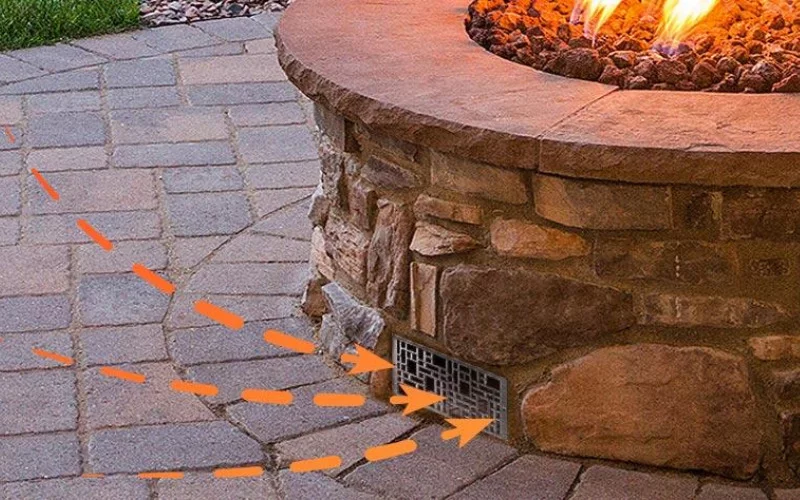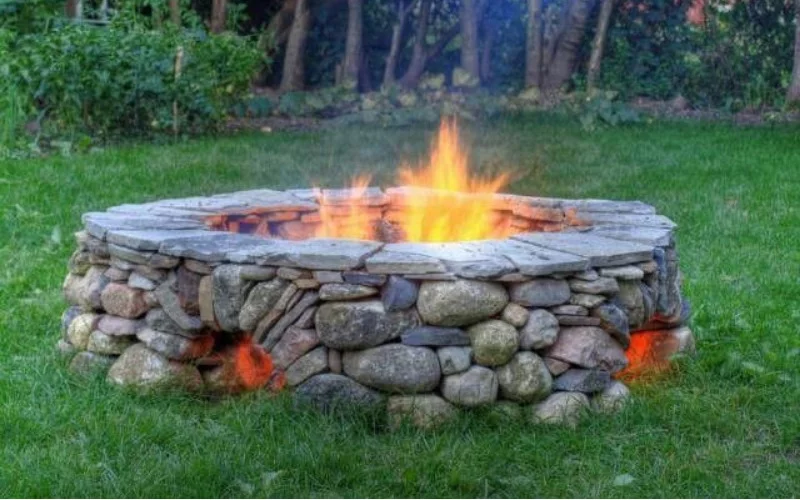Having a fire in your backyard seems like a great idea, especially during the summer. Gathering around a fire pit with friends and families is a great way to make new memories; that is why your priority is to ensure that your fire pit is safe to use and can also be kept in good shape.
There are a lot of things to consider when purchasing a fire pith; you find yourself asking if you need vent holes in your fire pit. You do need vent holes in your fire pit to ensure that you are safe.
Why Do Some Fire Pits Have Holes and Others Don’t
Fire pits that have holes are above the ground fire pits. These fire pits use holes for proper ventilation and to keep your pit glowing. Fire pits without air holes are called in-ground fire pits.
These fire pits are buried underground; it is pointless to make holes in an in-ground fire pit since these holes will end up being blocked by the ground.
But a pipe runs from the in-ground fire pit up to the surface to take air to the fire pit, be sure to use the suitable piping material with this type of fire pit.
Do I Need Vent Holes in my Fire Pit?

If you make a fire pit or purchase one, it will need air holes or proper ventilation. This ventilation helps your fire burn more as air containing oxygen comes into your fire pit, and it also prevents your fire pit surface from getting damaged.
You would want a 2-inch hole every 24 to 36 inch surface of your fire pit, and you should ensure that these holes are free of ash and debris.
Air holes in your fire pit are necessary for many reasons, so you must have air holes in your fire pit to make it safe for use. A large fire pit will have or require more holes than a normal one.
Smokeless Fire Pits
Not all fire pots require air holes, an example of a fire pit that doesn’t require ventilation is the homeless fire pit.
These fire pits are advanced and safer than both gas and wood fire pits; they are smokeless and odorless, unlike gas and wood fire pits that always have a hint of for in the atmosphere.
If you are not too hung up on the nostalgic smell of gas or wood fire pits, then this is highly recommended for you.
This in-ground fire pit has a vent tunnel. The vent tunnel takes air into the fire pit, aiding combustion; this fire pit is eco-friendly as it pollutes the atmosphere less. It also produces a large amount of heat compared to gas and wood fire pits.
Advice For Making Vent Holes
If you have decided to create vent holes on your fire pit all by yourself, you should use the right materials. Materials like plastic and PVC are not suitable for creating vent holes, they will melt on your fire pit, and the chemicals will burn, releasing fumes or chemicals that may be harmful to the body.
It is not recommended that you make these holes yourself.
Drilling vent holes in your fire pits can cause the sharp edge to get rusted, so it is better that you purchase a new fire pit with holes that the manufacturer created.
Fire Pit Safety Tips
Firepit safety is essential when using a fire pit; these tips will help you avoid possible fire hazards and other factors that could risk your health or damage your fire pit. The following tips should guide you on how to handle a fire pit.
- Always read the manufacturer manual. It comes with more safety requirements as well as maintenance tips.
- Always use your fire pit in an open space, as it needs ventilation. An indoor fire pit may be an exception, but it still needs a little air intake.
- Be sure that your fire pit is located far away from flammable materials like wood, bushes, and other materials. For extra caution, it is advised that you build a fire pit ring to secure your fire pit.
- Avoid any form of accelerant. These may include gasoline, diesel, or kerosene. Your fire is okay, just burning with wood or propane paired up with oxygen. Adding these substances could lead to a disaster.
- Always keep a fire extinguisher nearby. Sometimes, mistakes may be made with the fire pit, but it is better to quench a small fire on time than let it spread. Having a fire extinguisher on hand will prevent any small fire from growing.
- Adult supervision is required when children or pets are close to a fire pit. This prevents injury and a possible fire hazard.
- Be sure that you are well informed of your local laws, as fire pits are not allowed in some regions due to fire hazards; a few sparks of fire accompanied by some wind can cause severe damage. You may be granted a permit in some of these regions, but you should still inquire.
- Do not use plastic or any other chemically treated material on your fire pit. The chemicals in these materials will burn to release fumes that may be harmful and toxic to the health, accompanied by a foul odor.
Conclusion: Fire Pit Vent Holes
When handling a fire pit, everything needs to scream safety. Air holes or vents are necessary for your fire to burn well and ensure safe fire pit usage. It is advised that you use the right material to make vent holes, or better, purchase a new fire pit with already drilled vent holes.
You can also consider using smokeless fire pits that don’t need vent holes; it also has other benefits like producing more heat with less smoke and less pollution to the environment.
It is also essential that you confirm with local laws before purchasing or using a fire pit. Observing fire pit safety is key, and some essential tips are to use fire pits outdoors, avoid accelerants and keep a fire extinguisher close by.
You May Also Like:
- 6 Ways to Put a Fire Pit on a Wooden Deck
- How Do You Make a Square Fire Pit Insert? (12 Easy Steps)
- 4 Best Fire bowls You Should Choose From
- Is it Safe To Roast Marshmallows On a Propane Fire Pit?
- Can You Put A Fire Pit On Trex Composite Decking?
- High-Pressure vs Low-Pressure Propane Regulator – See Difference Between Them?
We trust this article helped you know how to make Fire Pit Vent Holes. You may also want to check out How To Make a Propane Fire Pit Smell Better.
Thanks for taking the time to read our article, and we hope you find it helpful. Would you mind leaving a comment below if you have any suggestions?
Kindly reach out to people by sharing this post on social media.
If you liked this article, then please follow us on Facebook, Instagram, and Pinterest.

